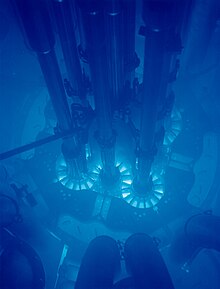
Back Tscherenkow-Strahlung ALS إشعاع تشيرنكوف Arabic Эфект Вавілава — Чаранкова Byelorussian Ефект на Черенков Bulgarian চেরেনকভ বিকিরণ Bengali/Bangla Radiació de Txerenkov Catalan Čerenkovovo záření Czech Cherenkovstråling Danish Tscherenkow-Strahlung German Ακτινοβολία Τσερενκόφ Greek

Cherenkov radiation (/tʃəˈrɛŋkɒf/[1]) (also known as Čerenkov radiation[2]) is electromagnetic radiation emitted when a charged particle (such as an electron) passes through a dielectric medium (such as distilled water) at a speed greater than the phase velocity (speed of propagation of a wavefront in a medium) of light in that medium.[3] A classic example of Cherenkov radiation is the characteristic blue glow of an underwater nuclear reactor. Its cause is similar to the cause of a sonic boom, the sharp sound heard when faster-than-sound movement occurs. The phenomenon is named after Soviet physicist Pavel Cherenkov.
- ^ "Cherenkov". Dictionary.com Unabridged (Online). n.d. Retrieved 26 May 2020.
- ^ "Cerenkov – Search | ScienceDirect.com". Science Direct. Archived from the original on 2024-01-22. Retrieved 2024-01-22.
- ^ Jackson, John David (1999). Classical electrodynamics (3rd ed.). New York: Wiley. pp. 637–638. ISBN 0-471-30932-X.